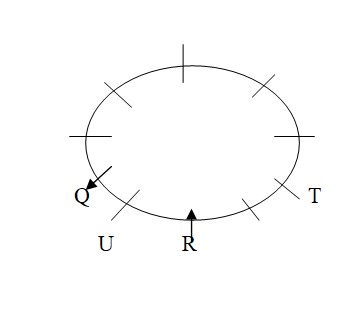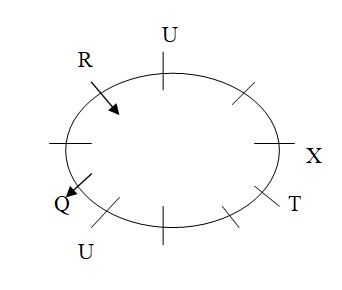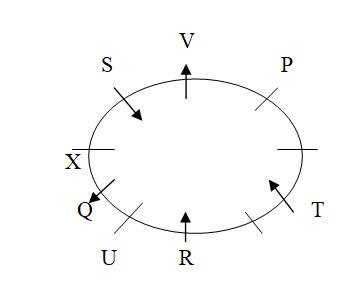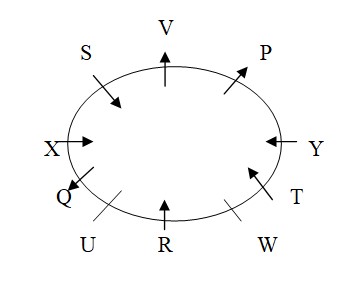Question
Who sits opposite to
R? Answer the questions based on the information given below. Ten persons P, Q, R, S, T, U, V, W, X and Y sit around a circular table such that four of them face outside while others face towards the centre. No two persons with names starting with consecutive alphabets are immediate neighbors of each other. T sits 4th to the left of Q, who faces outside. U sits immediate left of R, who faces towards the centre. U and Y face same direction as X. X doesn’t face outside. Two persons sit between X and P, who doesn’t sit 2nd to the left of T. S and V sits immediate left of each other. X sits 3rd to the left of R. S and T face same direction. Y doesn’t sit adjacent to R. V and W face same direction as P.Solution
T sits 4th to the left of Q, who faces outside. U sits immediate left of R, who faces towards the centre. X sits 3rd to the left of R. So, T sits either 2nd to the right of R or 4th to the left of R. Also, X sits either immediate right of Q or 5th to the left of Q. Case I: T sits 2nd to the right of R:  Case II: T sits 4th to the left of R:
Case II: T sits 4th to the left of R:  Two persons sit between X and P, who doesn’t sit 2nd to the left of T. S and V sits immediate left of each other, this is not possible in case II, so case II is rejected. S and T face same direction. So, S and T face towards the centre and V faces outside.
Two persons sit between X and P, who doesn’t sit 2nd to the left of T. S and V sits immediate left of each other, this is not possible in case II, so case II is rejected. S and T face same direction. So, S and T face towards the centre and V faces outside.  Y doesn’t sit adjacent to R. V and W face same direction as P. U and Y face same direction as X. X doesn’t face outside. So, W faces outside and sits adjacent to R and Y sits immediate right of T. Also, U and Y face towards the centre and P face outside. The final seating arrangement is given below:
Y doesn’t sit adjacent to R. V and W face same direction as P. U and Y face same direction as X. X doesn’t face outside. So, W faces outside and sits adjacent to R and Y sits immediate right of T. Also, U and Y face towards the centre and P face outside. The final seating arrangement is given below: 
A spent 20% and 25% of his monthly salary on food and rent, respectively. Of the remaining amount, he gave 20% and 30% to his mother and brother, respec...
In an exam, Rina scored 54% marks and failed by 80 marks whereas Tina scored 74% marks in the same exam and scored 60 marks more than the passing marks....
The ratio between the numbers of girls and boys in a class is 2:3 respectively. What is the percentage of girls in the class?
During a school council election, candidate X received 61% of the votes and beat candidate Y by a margin of 4,880 votes. Determine how many votes candid...
What is the percentage change in the result when we add 25 to a certain number x, instead of subtracting 25 from the same number x?
The income of P is 2/5th of the income of Q and income of R is 60% more than the income of Q. Income of Q is Rs.15000 and expenditure of P is...
A bulb-producing company found 17% of the total product defective. If the total number of nondetective products is 4565, then specify the number of tota...
Income of A is 60% of the Income of B and A together. The saving of B is 45% of his Income and equals to Rs. 8100. Find the difference between the incom...
Monthly income of P is Rs.14000 and his monthly savings is Rs.8500. If his monthly income is decreased by 30% and monthly expenditure is decreased by 25...
The marks scored by a boy in three subjects are in the ratio 2 : 3 : 5. Boy scored an overall aggregate of 60% in the exam. If the maximum marks in each...
Relevant for Exams:



